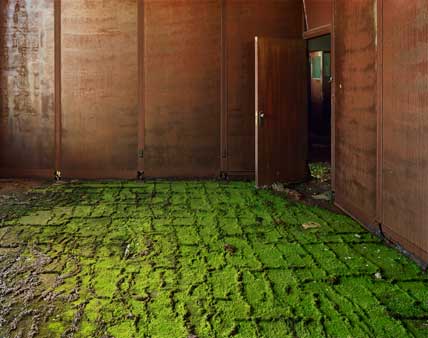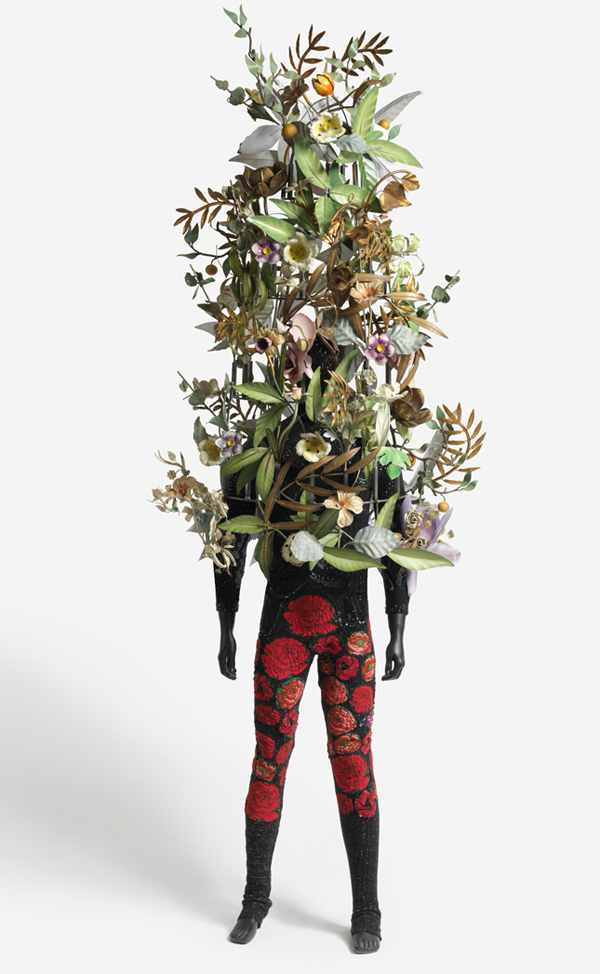
Andrew Moore (American, born 1957). Model T Headquarters, 2009. Chromogenic photograph, 50 × 60 in. (127 × 152.4 cm). Brooklyn Museum, Robert A. Levinson Fund, 2010.40

Andrew Moore (American, born 1957). Model T Headquarters, 2009. Chromogenic photograph, 50 × 60 in. (127 × 152.4 cm). Brooklyn Museum, Robert A. Levinson Fund, 2010.40

Nina Chanel Abney (American, b. 1982). Forbidden Fruit, 2009. Acrylic on canvas, 67 × 771⁄2 in. (170.2 × 196.9 cm). Brooklyn Museum, Gift of Mr. and Mrs. Warren Brandt and anonymous gift, by exchange, 2009.23
As she has done in the past, Nina Abney here creates a highly personal, imaginative, and eclectic interpretation of a literary source. Forbidden Fruit, part of a series inspired by Lewis Carroll’s Alice in Wonderland, alludes to the chapter featuring a hookah-puffing caterpillar. According to the artist, the composition of the figures and the choice of light blue and green were drawn from Henri Matisse’s 1909 painting The Dance. Sea-Monkeys (a species of brine shrimp sold as curiosities during the artist’s childhood) provided the model for the two figures with antennae sitting on the left, and the numbers that appear on various figures also have personal meaning for Abney. Though the original Alice is absent here, Abney’s boldly hued hallucinatory scene populated by fantastic creatures vividly simulates the magical environment of the text, in which Alice experiments with mushrooms that allow her to grow and shrink in size.

Nick Cave (American, b. 1959). Soundsuit, 2008. Mixed media, 82 × 24 × 24 in. (208.3 × 61 × 61 cm). Brooklyn Museum, Mary Smith Dorward Fund, TL2009.6
Nick Cave’s Soundsuit transforms the human body into an ornate still life. Since the early 1990s, Cave has been fabricating such inventive sculptures out of scavenged materials that he often overlays with beadwork, stitching, and other sorts of embellishments. One of his first Soundsuits, crafted from twigs, was made to be worn. In response to the movements of the wearer, it generated rustling sounds, giving a name to the resulting body of Cave’s work. The Soundsuits, which allow the wearers to assume new identities, allude to a range of rituals, from ceremonial African dances to Christian liturgy. Reflecting his training as a dancer, Cave’s creations explore the expressive potential of the body moving through space and as a support on which to compose with readymade materials.

Shinique Smith (American, b. 1972). Mitumba Deity, 2005. Fabric, clothing, twine, and cardboard, 48 in. (121.9 cm) high x 50 in. (127 cm) in diameter. Brooklyn Museum, Gift of the Contemporary Art Council, 2009.25
Sitting directly on the floor, like a Minimalist sculpture, Mitumba Deity consists of lumpy bundles of fabric, stuffed toys, and articles of clothing. Composed of Smith’s own garments and those of friends, the piece alludes to the global economy through the path of secondhand clothing. The piece was inspired by a film that tracks a T-shirt with a university logo from a thrift shop in New York to a mountain village in Africa, where it is purchased by a man and becomes his second shirt. Mitumba is a Swahili word that can be translated literally as “bundles”; it refers to the packages and articles of used clothing donated by people in prosperous countries to charitable causes. Mitumba Deity is from Smith’s series of bundle sculptures.

Jessica Jackson Hutchins (American, b. 1971). Kitchen Table Allegory, 2010. Table, ink, ceramic; table: 30 × 65 × 42 in. (76.2 × 165.1 × 106.7 cm); ceramic: 26 × 32 × 14 in. (66 × 81.3 × 35.6 cm). Brooklyn Museum, Gift of Edward A. Bragaline, by exchange, 2010.25a–b
Incorporating a well-worn wooden table and a misshapen ceramic bowl, Jessica Jackson Hutchins’s Kitchen Table Allegory evokes the private world of the home. This sculpture incongruously combines a castoff piece of furniture and a newly made ceramic vessel by the artist. The table served Hutchins and her family until she decided to use it as the plate for a series of prints that were initially presented with the sculpture. Personal without devolving into the confessional, the work situates the source of creative inspiration within the familial and the everyday.

Rashaad Newsome (American, b. 1979). Status Symbol #20, 2009. Collage on paper, 30 × 221⁄8 in. (76.2 × 56.2 cm). Brooklyn Museum, Robert A. Levinson Fund, 2010.9
A modern-day coat of arms assembled from images of luxury consumer items, this collage could be regarded as a catalogue of status symbols coveted by contemporary celebrities. Within the traditional heraldic format, the central image of rapper LL Cool J is flanked by large gold Rolex watches. Inspired by coats of arms on the facades of historical European buildings, Rashaad Newsome brings this tradition, which originated in the mid-twelfth century, into the present.

Sara VanDerBeek (American, b. 1976). A Composition for Detroit (detail). 2009. One of four chromogenic photographs; this panel: 65 × 431⁄2 in. (165.1 × 110.5 cm). Brooklyn Museum, Gift of the Contemporary Art Council, 2010.32a–d
A Composition for Detroit is a portrait of contemporary America. Inspired by many trips to Detroit and its banks of broken factory windows, some overpainted, Sara VanDerBeek built structures that functioned as supports for leaning panes of glass and a wide range of photographic imagery. She then photographed her ephemeral installations before dismantling them. Overall, the photographic material includes close-ups of images such as a Walker Evans photograph of the ruins of a pre–Civil War plantation in Louisiana and a Charles Moore picture of a crouching woman, sprayed with water, during a 1963 civil rights protest. VanDerBeek also used documentary material, some dealing with riots in Detroit in 1967, as well as her own evocative photographs of abandoned buildings and broken blinds. According to the artist, the visual allusions to windows, stairs, and doorways open up the possibility of either staying where we are or taking off in new directions.
That Place: Selections from the Collection
September 8, 2010–July 17, 2011
Our home, our street, our city, our country—these are familiar locations, places that define our lives. Yet places can be more than physical. Some of the works on view in these galleries evoke a literal place, either domestic or communal. Others, however, approach the concept of place metaphorically, with evocations of a social and cultural place or references to art history that offer a point of departure, where traditions can be reworked or reconsidered. The past—both personal and collective—occupies a significant place in our memories from which we see the present and imagine the future. Not limited to dwelling, the idea of place transcends geographical and temporal boundaries to include race, ethnicity, and gender in the creation of places where past and future, illusion and reality, meet.
That Place highlights recent acquisitions and presents them alongside notable works that entered the collection over the past four decades. The Museum’s collecting of contemporary art now focuses on work of the twenty-first century, which has seen the rise of Brooklyn as one of the most vibrant centers of cultural production in the world. Williamsburg, Greenpoint, and Dumbo, today established artists’ enclaves, have given way to Red Hook, Bed-Stuy, Gowanus, and Bushwick as frontiers that offer artists prospects for affordable work places. The Brooklyn Museum began collecting recently created works of art in the mid-nineteenth century; That Place demonstrates the Museum’s continuing commitment to living artists and to collecting distinctive art of our time.
The exhibition is co-organized by Eugenie Tsai, John and Barbara Vogelstein Curator of Contemporary Art, and Patrick Amsellem, Associate Curator, Photography, Brooklyn Museum.
The generous support of the John and Barbara Vogelstein Contemporary Acquisitions Challenge has made possible many recent additions to the collection featured in That Place: Selections from the Collection. This exhibition was also made possible in part with support from the FUNd.
The creation of the contemporary galleries was made possible in part through support provided by the New York City Council through the efforts of Council Member Bill de Blasio.